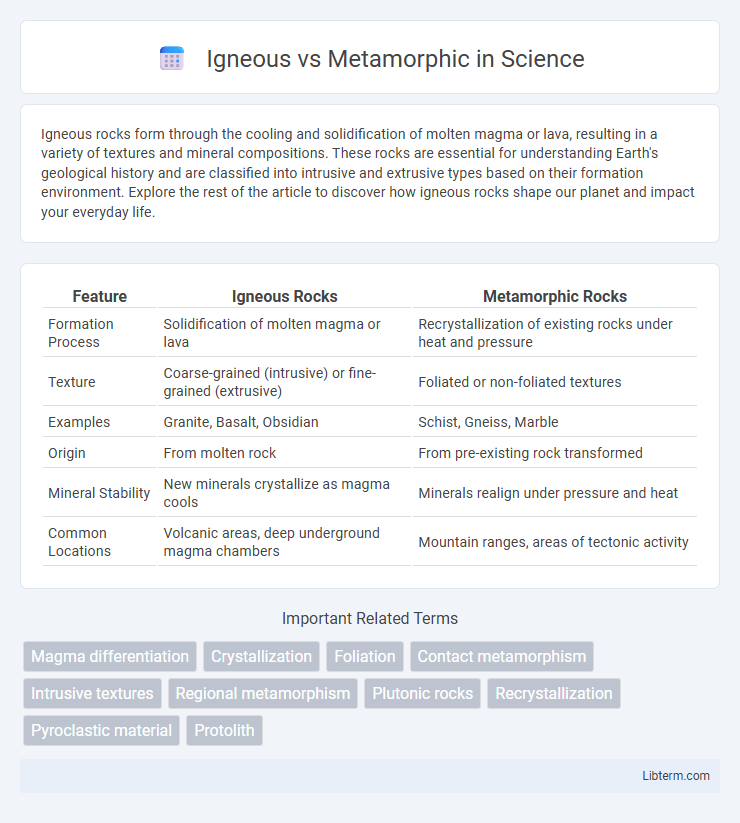Igneous rocks form through the cooling and solidification of molten magma or lava, resulting in a variety of textures and mineral compositions. These rocks are essential for understanding Earth's geological history and are classified into intrusive and extrusive types based on their formation environment. Explore the rest of the article to discover how igneous rocks shape our planet and impact your everyday life.
Table of Comparison
| Feature | Igneous Rocks | Metamorphic Rocks |
|---|---|---|
| Formation Process | Solidification of molten magma or lava | Recrystallization of existing rocks under heat and pressure |
| Texture | Coarse-grained (intrusive) or fine-grained (extrusive) | Foliated or non-foliated textures |
| Examples | Granite, Basalt, Obsidian | Schist, Gneiss, Marble |
| Origin | From molten rock | From pre-existing rock transformed |
| Mineral Stability | New minerals crystallize as magma cools | Minerals realign under pressure and heat |
| Common Locations | Volcanic areas, deep underground magma chambers | Mountain ranges, areas of tectonic activity |
Introduction to Igneous and Metamorphic Rocks
Igneous rocks form through the cooling and solidification of molten magma or lava, characterized by mineral crystals interlocked in a dense matrix, with granite and basalt being common examples. Metamorphic rocks arise from the transformation of existing rock types under high heat, pressure, or chemically active fluids, leading to mineral re-crystallization without melting, exemplified by slate and marble. Both rock types illuminate Earth's dynamic geological processes, revealing histories of volcanic activity and tectonic pressure.
What Are Igneous Rocks?
Igneous rocks form through the cooling and solidification of molten magma or lava, characterized by a crystalline texture that varies depending on the cooling rate. Common examples include granite and basalt, both integral to the Earth's crust composition. These rocks serve as primary sources for studying Earth's geological history and the processes of volcanic activity.
What Are Metamorphic Rocks?
Metamorphic rocks form through the transformation of existing igneous, sedimentary, or other metamorphic rocks under intense heat and pressure without melting. This process, called metamorphism, alters the mineral composition and texture, resulting in rocks like slate, schist, and gneiss. Metamorphic rocks often exhibit foliation or banding, distinguishing them from igneous rocks formed by the cooling and solidification of magma or lava.
Formation Processes of Igneous Rocks
Igneous rocks form through the cooling and solidification of molten magma or lava, with intrusive igneous rocks crystallizing slowly beneath the Earth's surface, resulting in coarse-grained textures. Extrusive igneous rocks cool rapidly on the surface, producing fine-grained or glassy textures. These formation processes contrast with metamorphic rocks, which develop from the alteration of existing rocks under heat and pressure without melting.
Formation Processes of Metamorphic Rocks
Metamorphic rocks form through the alteration of pre-existing igneous, sedimentary, or other metamorphic rocks under intense heat, pressure, and chemically active fluids within the Earth's crust. This transformation occurs without melting, causing mineral recrystallization and structural changes that result in foliated or non-foliated textures. Key processes include regional metamorphism driven by tectonic forces and contact metamorphism near magma intrusions.
Key Differences: Igneous vs Metamorphic
Igneous rocks form from the solidification of molten magma or lava, characterized by interlocking mineral crystals, while metamorphic rocks develop through the alteration of existing rocks under heat and pressure without melting. The texture of igneous rocks is often coarse or fine-grained depending on cooling rates, whereas metamorphic rocks exhibit foliated or non-foliated structures due to mineral realignment. Compositionally, igneous rocks typically contain primary minerals like feldspar and quartz, whereas metamorphic rocks feature recrystallized minerals such as garnet and staurolite.
Common Examples of Igneous Rocks
Granite and basalt are common examples of igneous rocks, formed from the cooling and solidification of molten magma or lava. Granite is an intrusive igneous rock characterized by its coarse-grained texture, while basalt is an extrusive igneous rock known for its fine-grained structure. Both rocks play significant roles in Earth's crust composition and provide valuable insights into volcanic and tectonic processes.
Common Examples of Metamorphic Rocks
Common examples of metamorphic rocks include slate, formed from shale under low-grade metamorphism, and schist, characterized by its foliated texture resulting from medium-grade metamorphism of mudstone or shale. Gneiss, another prevalent metamorphic rock, develops through high-grade metamorphism of granite or volcanic rocks, exhibiting distinct banding patterns. Marble, derived from limestone, showcases recrystallized calcite crystals, making it a widely used metamorphic rock in sculpture and architecture.
Uses and Significance in Geology
Igneous rocks, formed from cooling magma or lava, are fundamental in construction due to their durability and strength, commonly used for countertops, tiles, and building foundations. Metamorphic rocks, altered by heat and pressure, are crucial for understanding tectonic processes and are valued in sculpture and decorative stone for their unique textures and hardness. Both rock types provide essential insights into Earth's geological history and processes, aiding resource exploration and environmental studies.
Summary: Igneous vs Metamorphic Key Takeaways
Igneous rocks form from the cooling and solidification of molten magma or lava, characterized by mineral crystals and textures like granite and basalt. Metamorphic rocks result from the transformation of existing rock types under heat, pressure, or chemically active fluids, producing foliated or non-foliated textures such as schist and marble. Understanding their formation processes, textures, and mineral compositions is essential for identifying rock types in geology.
Igneous Infographic

 libterm.com
libterm.com